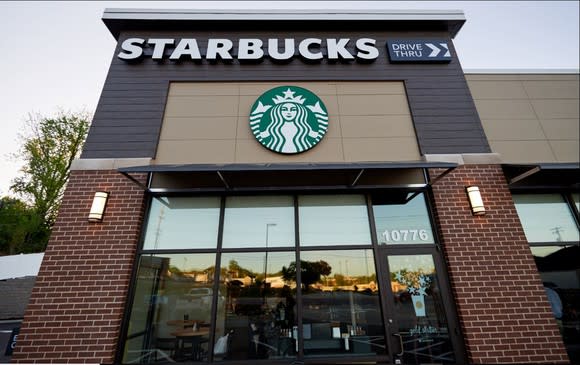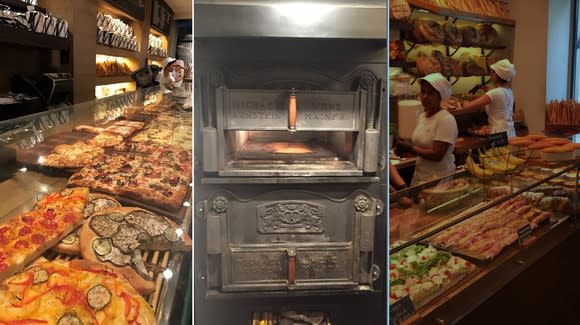2 Big Reasons Why I'm Not Worried About Starbucks
Shares of Starbucks (NASDAQ: SBUX) plunged more than 10% last week, after the company cut its full-year earnings guidance and warned investors that comp sales growth will be near 1% in the current quarter.
Management pointed to several contributing factors behind the slowdown. These included the decision to delay a marketing program following the April racial bias incident at a Philadelphia Starbucks location and a change in the availability of delivery services in China. Nevertheless, CEO Kevin Johnson made it clear that Starbucks' recent results haven't been acceptable.
The headline numbers may look scary for Starbucks investors, but the company has two big growth initiatives that are about to take off: digital personalization and Starbucks Reserve. As a result, I'm not worried about Starbucks. And while I had bad timing in buying some Starbucks stock earlier this month, I'm now thinking about buying even more.
Digital efforts are just getting started
Starbucks' digital savvy has been one of its key competitive advantages for many years. Just within the U.S., the company has 15 million active members in its My Starbucks Rewards program. Rewards members need to make their purchases using prepaid Starbucks cards, and most do so through Starbucks' highly rated mobile app.

Starbucks has 15 million active rewards customers in the U.S. Image source: Starbucks.
These digital relationships have two key benefits for Starbucks. First, usage of the app unlocks capabilities like mobile order and pay -- a win-win feature that adds convenience for customers and increases stores' productivity. Second, Starbucks can use data like a customer's purchase history for one-to-one marketing: i.e. customized offers optimized for each person.
Despite the recent slowdown in Starbucks' sales growth, it continues to see strong growth among its rewards members. However, that only accounts for 40% of its business. The other 60% comes from customers who haven't signed up for Starbucks Rewards and tend to visit less often.
Starbucks recently began working to gather email addresses and purchase data for many of these occasional customers. Just in the past 90 days it has created digital relationships with 5 million non-Rewards customers. It expects that total to keep growing.
Today, Starbucks is having some success in driving traffic from this slice of its customer base by emailing them non-personalized offers. A few months from now, it will be able to turn on its "personalization engine," which should dramatically improve the effectiveness of its marketing. Over the next few years, the combination of more digital relationships and more personalization will be a big sales tailwind for Starbucks.
Starbucks Reserve tests are just beginning
Way back in 2016, Starbucks revealed its plan to move further upmarket by creating a network of dedicated Starbucks Reserve stores and Starbucks Reserve coffee bars. The idea was that retail traffic is falling, and Starbucks must therefore step up its game to drive customer traffic.
The Starbucks Reserve concept represents a bet that stores serving made-to-order super-premium coffee will be more of a destination. The full-fledged Starbucks Reserve stores (as opposed to Starbucks Reserve bars in regular Starbucks stores) will be further differentiated by serving food that is made in-house.

Starbucks Reserve stores will serve fresh food made in-house. Image source: Starbucks.
In the long run, Starbucks believes that it could operate 1,000 Starbucks Reserve stores, with average unit volumes being twice that of a typical Starbucks cafe. These would be supported by as many as 20-30 Roastery locations, each capable of dramatically higher sales volumes. Finally, 20% of Starbucks' global store base could accommodate Reserve coffee bars.
However, there are only two Roastery locations operating today. Four more will open by the end of 2019, after which Starbucks plans to pause on expansion for a while. There is only one full Starbucks Reserve store open so far, with another six to 10 set to open later this year. Starbucks will work to refine the Reserve store business model over the next year or two before rolling it out more broadly.
Finally, there are 35 Starbucks Reserve bars in the U.S. and Canada, along with about 150 in China, where the concept was first developed. Starbucks plans to add these Reserve bars to thousands of stores over time, driving increased traffic and sales.
The growth drivers are coming
Creating digital relationships with customers and sending targeted offers is a proven strategy that Starbucks has used to increase sales among its rewards members over the past few years. As the company expands its base of My Starbucks Rewards members and gains the ability to engage with more non-rewards customers, it's extremely likely that sales growth will accelerate.
Starbucks Reserve is more of an unproven concept for now. However, it's very promising, based on the incredible sales volumes achieved in the first two Roasteries. (Furthermore, comp sales growth remains stellar in the Seattle Roastery, which has been open for several years.)
Over the next two years, Starbucks' digital efforts should rejuvenate comp sales growth. By 2020, the Starbucks Reserve concept will hopefully be ready for prime-time, unlocking further growth opportunities. As a result, the recent Starbucks stock slump seems like an overreaction -- and an attractive buying opportunity.
More From The Motley Fool
Adam Levine-Weinberg owns shares of Starbucks. The Motley Fool owns shares of and recommends Starbucks. The Motley Fool has a disclosure policy.

 Yahoo Finance
Yahoo Finance 